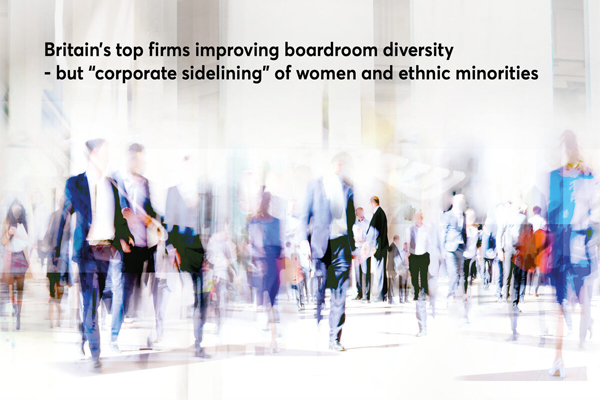Britain’s female and ethnic minority business leaders remain largely concentrated in functions such as HR, diversity, marketing or communications, which are less likely to lead to C-suite roles, according to a new report from executive recruitment and diversity consultancy Green Park.
Its latest annual FTSE 100 Business Leaders Index reveals that despite some progress on diversity in the upper echelons of Britain’s top companies, ethnic minorities and females are still being shunted into functions that are far less likely routes into the top tier of leadership; than those travelled by their White, male counterparts.
Most analyses of corporate CEO backgrounds show a preference for executives with experience in finance, sales and operations. However, Green Park’s annual study reveals that Britain’s female and ethnic minority business leaders remain largely consigned to functions such as HR, diversity, marketing and communications; which hold less influence, have lower salaries and are less likely to be on track to C-suite roles.

LEAST DIVERSE ROLES & FUNCTIONS
The Index also shows that there are no Black leaders in C-suite roles at FTSE 100 companies; dropping to zero after stalling for the past six years. “This would appear to confirm that ethnic minority leaders are diverted towards the pathways least likely to lead to the top,” noted the report.
In fact, some functions are dominated by one particular gender or ethnicity, at the ‘Top 40’ pipeline level. Green Park’s research found that 85.4% of Diversity & Inclusion leadership roles at FTSE 100 companies are held by women. Around 62.5% of Diversity and Inclusion leaders are White women; with ethnic minority females the second most represented group at 22.9%. Ethnic minority males are the least represented in this function at just 6.3%. Interestingly, the survey revealed that one of the least diverse functions is diversity and inclusion; which is disproportionately a White and female preserve. In fact, nearly two out of three of these senior roles are filled by White women.
Human Resources is also predominantly a White female enclave at 55%. White men dominate in the digital, data and technology space (76%) governance and operations (73%), commercial and procurement (71%) and finance (69%) professions/functions; which are all much more direct routes to the top.

HIRING DIVERSE SENIOR EXECUTIVES
Green Park’s track record of placing 53% female and 35% ethnic minority candidates into board level roles over the past year demonstrates “that diverse leadership talent is out there”; and that “businesses are receptive to hiring diverse senior executives across a range of functions”. However, companies need to do more to improve diversity at the top.
“We as business leaders must do more to improve the diversity of our boards and leadership teams,” stated Change the Race Ratio’s Chair & Founder, and CBI’s President, Lord Karan Bilimoria. “What I hear from my conversations with Chairs and CEOs is a clear desire to make progress; and an openness to embracing new thinking that’s needed to deliver change. I welcome the recommendations set out in this report; and I encourage business leaders to adopt them. We must transform words and promises into action and results.”
Among the key recommendations, the consultancy encourages organisations to adopt a new rule to highlight any key business decisions; such as major appointments or acquisitions, taken by a leadership team which is all male or all-White. The company’s own board has instructed that under the “Green Park Rule” any spending decision above 1% of turnover must be made by a diverse group. If this is not possible, the fact should always be reported to the board and noted in the company’s annual report. At Green Park, this rule typically covers any major investment decision, acquisitions or senior appointments. Click here for more information about the report.
CBI’s President Lord Karan Bilimoria is also calling for FTSE 100 firms to have at least one racially and ethnically diverse board member by the end of 2021. He wants FTSE 250 firms to achieve the same representation by 2024. Click here to read more.







































